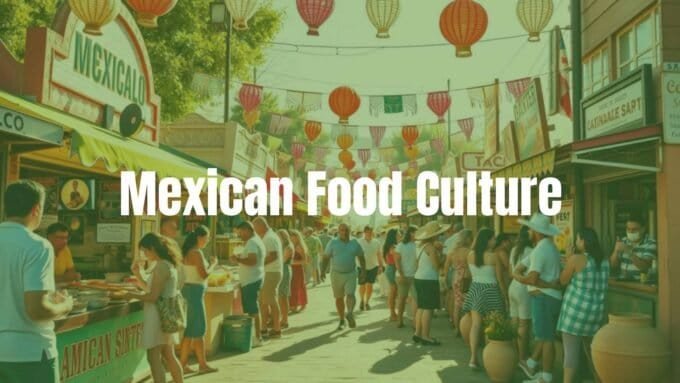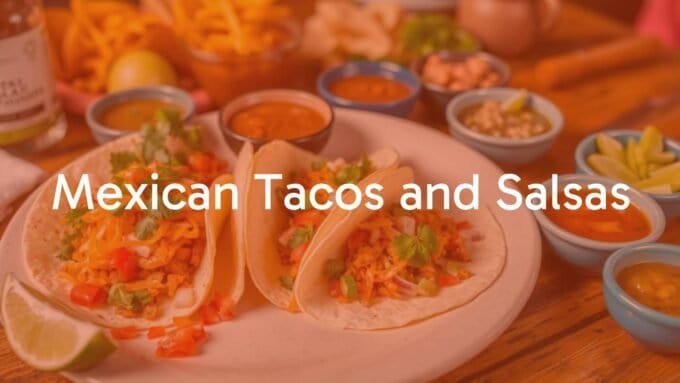Traditional Mexican recipes are much more than lists of ingredients and steps; they are a living piece of Mexican culture filled with stories, community, and history. When we talk about “traditional Mexican recipes,” we mean a full way of cooking and eating, starting with how ingredients are grown and ending with people sharing meals together. These recipes have been handed down from one generation to the next, keeping Mexico’s spirit alive in every dish.
The strength of Mexican food comes from its original flavors, which show the country’s past and the many cultures that have influenced it. While many world cuisines have been made simpler, real Mexican cooking holds onto its complex and unique qualities. This pride in Mexican food’s roots is so important that UNESCO listed it as a piece of world heritage, especially recognizing the food of Michoacán. This puts Mexican cuisine on the same level as some of the world’s greatest landmarks, showing how special and valuable it is. Mexican food celebrates tradition while also growing and changing with time, inviting everyone to enjoy its true flavors.

What Makes a Recipe “Traditional Mexican”?
Cultural Value of Mexican Cooking
Traditional Mexican food isn’t just about filling your stomach; it’s deeply joined to Mexico’s identity. The way food is grown – like “milpas” (fields where corn, beans, and squash are rotated) and “chinampas” (artificial islands for farming) – shows respect for the earth. Rituals and old cooking skills, especially those kept up by female cooks in regions like Michoacán, help keep traditions alive and strengthen communities. These collective efforts help build stronger local and national bonds.
Everyday foods like tortillas and tamales carry great meaning. They are often part of offerings during events such as Día de los Muertos (Day of the Dead). Mexican food is known worldwide because it connects food, ritual, and community, making it a vital and unique part of Mexico’s identity. Each meal, from simple family dinners to big festivals, tells the ongoing story of Mexico.
Common Cooking Methods and Ingredients
Traditional Mexican cooking uses techniques and ingredients that go back thousands of years. Nixtamalization-where corn soaks in lime-does more than add flavor and texture: it also boosts the nutrition of the corn. This turns corn into masa (dough), which is the base for tortillas, tamales, and more.
Other key tools are grinding stones (metates) and stone mortars (molcajetes), which help bring out the best tastes and smells from ingredients. Local vegetables and spices like tomatoes, squashes, avocados, cocoa, and vanilla are key parts of the food, alongside basic items like corn, beans, and chilies. These methods and ingredients are what give Mexican food its special character.
Main Ingredients in Real Mexican Food
Bases: Corn, Beans, and Chilies
The three main boosters of Mexican cooking are corn, beans, and chilies. Corn has been a main food for about 7,000 years. The saying “Mexico is corn, corn is Mexico” reflects its importance, and according to the Mayan story “Popul-Vuh,” people were made from corn. Through nixtamalization, corn becomes masa, which is used for making tortillas, tamales, sopes, and more. Beans – like black, pinto, or charro – bring needed protein and a creamy taste, showing up in many dishes. Chilies, found in many shapes and levels of heat, give Mexican food its signature kick, and are used fresh, dried, and in salsas, moles, and stews.
These three ingredients are more than food; they are symbols of history, farming, and Mexican cooking itself. They can be used in countless ways, and almost every traditional dish relies on them, showing how important they are to the cuisine.

Fresh Herbs and Local Spices
Herbs and spices add layers of taste to Mexican food. Cilantro, known for its bright flavor, is found in many dishes or used as a topping. Epazote, with its special smell, is common in bean dishes. Mexican oregano, different from the regular kind, is earthier and brings out classic Mexican flavors.
Spices like dried chilies (ancho, guajillo, pasilla), cumin, cinnamon (“canela”), cloves, and allspice are common. They’re often toasted for extra aroma, especially in sauces. Mixing these herbs and spices the right way creates the memorable flavors found in Mexican cooking.
Traditional Cheeses and Creams
Some cheeses and creams are part of Mexican food, though sometimes they play a smaller role than in American variations. Cotija, a salty, crumbly cheese, is sprinkled on tacos, enchiladas, and corn dishes as a final touch. Oaxaca cheese is stringy and melts well, making it perfect for quesadillas and baked foods.
Crema Mexicana, a rich, slightly sour cream, is drizzled on soups, tacos, and enchiladas for coolness and a creamy finish. Homemade fresh cheese is also used often. When added in the right amount, these dairy products give extra flavor and texture without overwhelming the main ingredients.
Traditional Mexican Dishes
Tacos and Tortillas
Tacos are the most famous part of Mexican food, but the traditional versions are often simple and focused on quality tortillas. The tortilla, usually made from corn, is the base, and fillings range widely. Examples include Carne Asada (grilled beef), Tacos al Pastor (marinated pork and pineapple), Tacos de Suadero (tender beef), Crispy Potato Tacos, and Crispy Pork Flautas (rolled tacos). Breakfast versions, filled with eggs and chorizo or potatoes, are also common. Tacos are usually topped with lime, onion, cilantro, and fresh salsa.
Tortillas are a must in Mexican kitchens. They’re made as Corn Tortillas or Flour Tortillas. You’ll also see tostadas (crispy tortillas topped with meat or vegetables), sopes (thicker tortillas with raised edges), and more. Learning about tortillas helps you understand what makes Mexican food unique.
Enchiladas and Salsas
Enchiladas show how tortillas and salsas come together. They’re made by filling tortillas, rolling them up, and covering them with sauce. Choices include Green Enchiladas (Suizas) with tomatillos and cheese, Red Enchiladas with chile sauce, Tabasco-Style Enchiladas with picadillo, and Creamy Poblano Enchiladas. Similar dishes are Entomatadas (tortillas dipped in tomato sauce) and Enfrijoladas (in bean sauce).
Salsas are central in Mexican food. They can be Salsa Verde with tomatillos, Salsa Roja, Roasted Tomatillo Salsa, Pico de Gallo, or even Creamy Jalapeño Salsa. With a wide range from mild to hot, salsas bring out the best in any Mexican dish.
Tamales and Masa Dishes
Tamales are at the core of Mexican celebrations and family life. They are made by spreading masa (corn dough) on corn husks or banana leaves, filling them with meat, beans, cheese, or fruits, and steaming them. Tamale-making is usually a group activity, especially around holidays. Popular fillings are Red Chile Pork, Chicken with Green Salsa, Bean Tamales, and sweet versions like Sweet Tamales.

The process starts with nixtamalized masa, using traditional methods or quicker ones with pre-mixed masa harina. Masa is also used to make tortillas, sopes, and gorditas, showing how flexible and essential it is to Mexican cooking.
Mexican Soups and Stews
Hearty soups and stews are pillars of Mexican comfort food. Dishes like Red Pozole (hominy stew with pork), Green Pozole (with tomatillo broth), Caldo de Res (beef soup), and Chicken Soup are regular meals.
Other common stews are Ground Beef Stew, Guajillo Pork Stew, Shrimp Soup, Lentil Soup, and Tortilla Soup. These dishes use local ingredients and bring people together for a meal that fills both body and soul.
Breakfast Dishes
Breakfast in Mexico is usually hearty. Common dishes are Papas con Huevo (potatoes with eggs), Huevos con Chorizo, and Huevos a la Mexicana (eggs with tomatoes, onions, and chilies).
Other classic choices are Chilaquiles (tortilla pieces in salsa), Eggs Motuleños, Eggs with Beans, and Machaca with Eggs. These meals often use simple foods to make balanced and filling morning plates.
Popular Street Foods
Mexican street food offers quick, bold tastes. Favorite picks include Elote (corn on the cob with mayo, cheese, chili, and lime) and Esquites (corn served in a cup).
- Tacos: Tacos de Suadero, Tacos al Pastor
- Pambazo: chili-dipped sandwich with potatoes and chorizo
- Sopes: thick masa discs with toppings
- Molletes: bread with beans and cheese
- Fruit with piquín pepper
Street food is a big part of daily life in Mexico and helps visitors taste the real local flavors.
Classic Mexican Side Dishes
Traditional side dishes include:
- Arroz Rojo (Mexican Red Rice)
- Mexican White Rice with Corn
- Refried Beans
- Beans from the Pot
- Borracho Beans (with beer and bacon)
- Zucchini with Cheese
- Zucchini & Corn
- Creamy Poblano Potatoes
- Elote (Street Corn)
These sides make meals complete and offer a gentle contrast to spicier mains.
Desserts
Popular traditional Mexican desserts are:
- Mexican Rice Pudding
- Tres Leches Cake
- Sweet Tamales
- Mexican Wedding Cookies
- Capirotada (Bread Pudding)
- Conchas (Sweet Bread)
- Berries with Cream
- Fresas Con Crema
These desserts bring together comfort and flavor using simple, everyday ingredients.
Mexican Drinks
Traditional drinks include:
- Watermelon Agua Fresca
- Melon Water
- Cucumber Agua Fresca
- Hibiscus Tea (Jamaica)
- Horchata (Sweet rice drink)
- Champurrado (chocolate drink)
- Atole de Nuez
- Ponche Navideño (Christmas Punch)
These drinks are enjoyed throughout the year and often pair perfectly with Mexican meals.
Regional Differences in Mexican Food
Mexico has a huge variety of foods because each region uses what grows locally and follows old customs. Food changes from the north to the south, and from coast to coast, making Mexico’s food rich and different depending on where you go.
Northern Specialties
The north relies more on beef, flour tortillas, and milder spices. Dishes like Carne Asada, Discada Norteña, and Pork Stew (Nuevo León Style) are well-known. Grilled meats are common, and meals often have a smoky taste.
Central Mexican Food
The area around Mexico City and Puebla is famous for complex sauces and many vegetables. Mole Poblano and Chiles en Nogada (stuffed poblano peppers with walnut sauce) are classic dishes. Food here often blends old and new ingredients for deep, layered tastes.
Oaxaca and the South
Oaxaca is famous for its seven types of mole and unique foods like Tetelas (filled masa pockets) and even grasshoppers (chapulines). In Yucatán, Mayan traditions are strong, and dishes like Cochinita Pibil (pork with annatto and citrus) and Xec Salad stand out. Southern Mexican meals are bright, often spicy, and closely tied to local traditions.

Coastal and Seafood Meals
With two long coastlines, Mexico is known for seafood. Typical plates include:
- Shrimp Cocktail
- Shrimp Ceviche
- Aguachile (shrimp with chili and lime)
- Veracruz White Fish
- Baja Fish Tacos
Seafood dishes here focus on fresh taste and often include local fruits and herbs.
Holiday and Special Occasion Foods
Special days in Mexico mean special foods. These recipes are handed down and are part of celebrating family, friends, and culture. Each event brings its own dishes and memories.
Día de los Muertos
The Day of the Dead relies on food to honor loved ones who have passed. On altars (“ofrendas”), people place favorite foods and Pan de Muerto (sweet bread), tamales, and mole. These foods are symbols of remembrance and love.

Christmas and Posadas
At Christmas, dishes like Ponche Navideño, Salted Cod, Roasted Pork Leg, and plenty of tamales are made for gatherings. Buñuelos and Capirotada are popular desserts during these times.
Cinco de Mayo
This holiday is celebrated with food like tacos, Chicken Chile Verde, Shrimp Cocktail, and aguas frescas (fruit drinks). Meals are easy to share and full of Mexican flavor.
Vegetarian and Vegan Choices in Mexican Food
Many traditional Mexican recipes are already vegetarian or vegan, thanks to the main use of foods like corn, beans, chilies, and vegetables. Even before European foods arrived, most people in Mexico ate plant-based diets, so it’s easy to find meat-free meals that are still traditional and delicious.
Vegetable-Forward Regional Foods
Plant-focused dishes include:
- Black Beans and Rice
- Calabacitas (zucchini with or without cheese)
- Nopalitos Salad
- Lentil Soup
- Potato Tacos
Plant-based stews, tacos, and tamales are easy to make and taste great with local herbs and spices.
Adapting Recipes
Since many Mexican foods use corn, beans, and vegetables, adapting them for diets without meat or dairy is straightforward. For example, use mushrooms or more beans instead of meat, and go for dairy-free cheese or cream when needed. Many salsas and guacamoles are naturally vegan. The main thing is to keep the traditional taste and texture, so meals still feel like Mexican cooking.
How to Make Traditional Mexican Food at Home
Cooking traditional Mexican recipes at home lets you enjoy flavors and culture from your own kitchen. Here are some key tips:
Choosing Real Ingredients
- Pick fresh, ripe vegetables like tomatoes, onions, and garlic.
- Use the right type of chilies – fresh or dried – as each has its own taste.
- Buy masa harina made from nixtamalized corn for tortillas and tamales.
- Try real Mexican cheeses and herbs (like Cotija, Oaxaca, epazote, and Mexican oregano) for unique flavor.
- Find ingredients at Mexican grocery stores or markets if possible.
Making Salsas and Tortillas
- For salsa, roast chilies and tomatoes to bring out their flavor or use a molcajete for grinding.
- Try making homemade corn tortillas or homemade flour tortillas. Use fresh masa and cook on a comal for the best results.
- Homemade tortillas taste much better and make your meals more authentic.
Storing and Serving Food
- Store leftover stews, tamales, and sauces in the fridge and reheat as needed. Some taste even better the next day.
- Freeze extra portions for busy days.
- Sides like onion, cilantro, lime, and salsa let everyone build their own plate.
- Warm tortillas and a welcoming table make the meal special.
Clearing Up Misunderstandings about Mexican Food
Many people outside Mexico get the wrong idea about Mexican cooking. Knowing what makes true Mexican food helps show its real depth and range of flavors.
| Tex-Mex vs. Authentic Mexican | What’s Different? |
|---|---|
| Tex-Mex | Lots of yellow cheese, ground beef, and cumin; hard-shell tacos, chili con carne, and big burritos. |
| Traditional Mexican | Fresh chilies, corn-based foods, more slow-cooked meats, and a range of sauces (like mole). More varied and regional. |
Both can be tasty, but knowing the difference helps you appreciate the real variety in Mexican cooking.
True Mexican Flavors
Not all Mexican food is spicy. Different chilies bring different flavors – some are mild and some are very hot. The best Mexican dishes balance flavors like masa’s earthiness, lime’s sharpness, the smoky taste of roasted chilies, and good slow-cooked meats or veggies. Real Mexican recipes focus on freshness and tradition, showing off thousands of years of food history in every bite.














Leave a comment